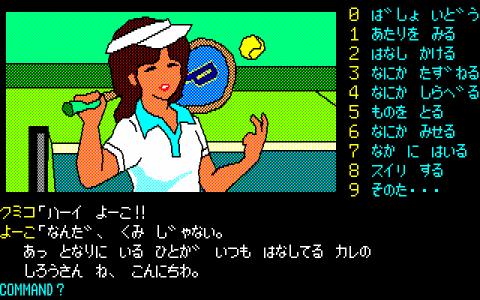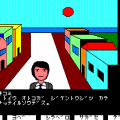- Portopia Renzoku Satsujin Jiken
- Hokkaido Rensa Satsujin: Ohotsuku ni Kiyu
- Karuizawa Yuukai Annai
The final game in the Horii Mysteries trilogy is also the least known. While still being a text-driven mystery adventure game, Karuizawa Yuukai Annai is a departure from its two predecessors in many ways. Two things stand out from the get-go: you no longer play as a police investigator, and the story contains more adult-oriented ecchi/fanservice situations and illustrations (the 2005 mobile cover even has the word eroticism as one of its taglines). The game was never ported to the Famicom – the platform on which Portopia and Okhotsk saw its largest audiences – likely due to its story and presentation, and it has never been translated into English.
As is the series’ tradition, the title of the game contains the geographical location in which it is set: in this case Karuizawa, which is located northwest of Tokyo in the Nagano Prefecture. The full title is commonly translated into English as The Karuizawa Kidnapping Guide, which has a very dark tone to it considering its ecchi themes. While annai definitively can be translated as “guide”, it can also mean e.g. “information”, “document” or “report”. With a little liberty of localization, an alternative title could thus be The Karuizawa Kidnapping Files, which make it sound less like a creepy hostage taking-simulator. It can also be noted that, unlike the preceding games, the verbs in the selection menu are conjugated in plain and not imperative form, since your main character does the actions himself and does not order a subordinate. The protagonist is also actively speaking here, which is a first for the series.
PC-8801
You play as a young man named Shirou Sakaki (or a custom name of your choice) from Tokyo who is visiting his girlfriend and her sister in their holiday home in Karuizawa. Kumiko Takagi, your girlfriend, is home alone when you arrive and the two of you seize the opportunity to get cozy with each other while her little sister Nagisa is on an errand to the supermarket. But as the evening passes without her return, you get worried and call the police, who promise to look into it. Come the next morning, Nagisa is still nowhere to be found, and you and Kumiko start looking for her. You eventually find Nagisa’s wallet on the side of a walking trail. There’s money still inside, but also a single tarot card: Death. As you investigate different spots and talk to the locals in and around Karuizawa, you learn more about some suspicious activities in the region and the allegedly accidental death of the parents of Kumiko and Nagisa a few years back. However, just as you’re making progress, your girlfriend reveals an existential secret that makes you question who she really is and if there is a kidnapping at all. Well, at least until you get an anonymous phone call threatening you to return to Tokyo and forget the whole thing…
PC-8801
Karuizawa is a game that wants to achieve many different things, and the end result is a quirky and a times frustrating mixture of ideas and gameplay conventions. The first and third of the games six chapters play a bit like a visual novel as they are just long dialogue trees between the two main characters. The rest of the chapters play like the previous Horii Mysteries but add an overhead map screen, which, interestingly, goes against Horii’s stated design principle from Portopia in which all intermediate traversal was cut to make the game more filmic. For most of the time, the map is just there to create a sense of world, since the quick-travel option still remains. However, in the fifth chapter the game breaks the established map screen mechanics and suddenly expects you to interact with location icons with a variety of verbs while on the map. Also, a major part of this chapter takes place inside a big villa, in which the verb menu is exchanged to a point-and-click interface with cardinal direction movement. But of all its genre amalgamations, this game is probably most known for its endgame sequence which is an Ultima style turn-based RPG; this make Karuizawa not too dissimilar to Koei’s text adventure-RPG hybrid Dragon & Princess (1982). Seeing that Horii’s next game would be Dragon Quest, this is many ways the link between his careers as an adventure game and a JRPG designer.
PC-8801
The RPG section is very rudimentary and plays more like a puzzle than a JRPG battle system. At this point in the game, you control a party of three characters. When you attack an enemy, you are given a choice of 2-3 different commands, but only one per character actually has a function. The two girls have novelty attacks that decrease enemy defence (blow kiss and flash underwear…) and the main character is the one who does the damage with his fight command. Defeating an enemy and picking up power-ups increase your stats, and the puzzle is to figure out in which order to kill the thugs in order to be strong enough to be victorious. There is a healing spring that can be used unlimited time, and is a must between the fights. If you die, the RPG section restarts from its beginning.
MSX
The degree of the naughty content varies throughout the game: it’s frequent in the first half where they it’s used to try to illustrate the intimate relationship between the main character and Kumiko, but since there are no dating sim elements these illustrations add little to the narrative and gameplay. Towards the end of the game, the sexual themes instead start to be played for laughs (for instance in the RPG attack options), in a way that today feels very outdated. However, even if these illustrations were to have been toned down, the game would probably have a hard time getting ported to the Famicom, since a large part of the plot concerns an illegal drug ring – much more so than the single drug peddler in Portopia.
MSX
Unlike Okhotsk, which was developed by a team at Loginsoft in parallel to this game, Karuizawa was a one man effort by Horii himself, and the different levels of narrative polish between these titles clearly show. In Horii’s usual style, the writing is succinct and deliberately requires the player to piece things together themselves. To a modern player, this might seem overly obtuse, but this is par-for-the-course for many ADV games from the 80s, as players were expected to struggle to solve a game for months. Instead, where Karuizawa falls short is the inconsistency of the exposition. This is a long game, and most of the time you are left with multiple dangling plot threads and little direction of what you are supposed to do next. This style of writing worked much better in Portopia since that is a much shorter game. Indeed, Karuizawa’s design is somewhere between Portopia and Okhotsk when it comes to open-endedness: Horii is clearly going for investigative realism in this trilogy, which is a big part of the appeal. In the end, however, only Okhotsk manages to keep a good balance between stumbling around and directing the player.
Since the game has a verb selection menu and no fail-states, the game sometimes tries to prevent you from brute-forcing it by implementing a number of countermeasures. In increasing degree from “reasonable” to “how was I supposed to guess that?”, some of the measures include: you have to say hello every time you visit a character to be able to ask and show them things, and some people only give you important dialogue the second time you visit them; the aforementioned map interaction and pixel hunting point-and-click interface of chapter five; and, the biggest of all, in the fourth chapter you are given clues to where to find a buried object, but in order to actually dig it up, despite having found a shovel earlier, you need to press a specific key on the keyboard that the priest tells you in a fourth wall-breaking message from God. Also, as a means of copy-protection, the game packaging came with a photo of Nagisa that is a clue to one of the final puzzles in the game, the answer to which needs to be input by parser.
The hint photo that came in the box
All ports of Karuizawa are highly similar. The PC88, X1 and FM-7 versions are identical, save for the media format the game was distributed on. The PC88 and X1 came on floppies and thus supports save games. The FM-7 and PC6001 ports came on multiple tapes and a password is given at the end of each tape that needs to be entered upon boot of the next; the MSX version, which came on cartridge, also uses passwords. The MSX and PC6001 ports have redrawn, but highly faithful graphics. In the PC6001 version the default name of the main character is Yuuji Enix (i.e. Horii himself), for some reason. The MSX port does have a more difficult RPG section: you cannot beat the second to last boss with the stats you’ve gained from defeating all the previous thugs, and instead you need to go back to the start of the map and trigger a respawn of all thugs, then kill them again in order to get enough stats; none of this is communicated to the player in-game. The mobile ports are probably lost to time, but are said to have toned down the sexual-themed attacks of Asami in the RPG section by e.g. having her special weapon being a bunny suit instead of sexy lingerie.
In all, Karuizawa is an obscure curiosity that attempts an unusual mix of styles but leans a tad bit too much on roundabout means of progression and excessive fan service for its own good. This, combined with how the demographic that would be interested in playing an untranslated Japanese 1980s mystery adventure like Karuizawa today is likely not the biggest to begin with, make it difficult to give this game a strong recommendation – especially since its sibling Okhotsk is clearly the superior game and has better stood the test of time. However, for players who want to see what peculiar directions this game took compared to its predecessors and how it segues Horii’s adventure games to his RPGs, it might well warrant a look.
Yuuji Horii Mysteries – Unreleased games
Two more Horii adventure games were announced, but were never made. Kowloon Fang (九龍の牙) would have been set in Hong Kong, and The Witness Who Disappeared in the White Night (白夜に消えた目撃者) in Soviet Russia. Articles about planned location spotting and development were published in Login Magazine (August 1984 and November 1985, respectively), just like how they had done with Okhotsk. Both games were planned to be made in collaboration with Loginsoft, but as the focus was shifted to porting Okhotsk to the Famicom, these two games were cancelled. By that time, Dragon Quest was already a blockbuster phenomenon, and it is understandable that Horii focused on his RPG series instead.
Storyboard for The Witness Who Disappeared in the White Night from Login Magazine March 1986.
Screenshot comparisons
PC-8801
FM-7
Sharp X1
PC-6001
MSX
Mobile (2003)
Mobile (2005)
References and further reading
In-depth interview in Japanese with Horii in Automation (2017), Part 2 covers Okhotsk and Karuizawa, and Part 3 the unreleased games (including screenshots of the magazine articles):
https://automaton-media.com/articles/interviewsjp/20171216-59190/
https://automaton-media.com/articles/interviewsjp/20171217-59192/
“Walkthrough” with a full transcript of the dialogue (in japanese):
https://w.atwiki.jp/storyteller/pages/943.html
Gameplay and translation notes from playing Karuizawa, made during the research of the current article:
https://scentoftheobscure.blogspot.com/2020/02/notes-from-my-playthough-of-karuizawa.html
Translated version of the Japanese Karuizawa Wikipedia article, that suggested to localize annai as “files” rather than “guide”:
https://www.reddit.com/r/readingJapanese/comments/bnuo8j/the_karuizawa_kidnapping_files/
Original sites for the 2003 and 2005 mobile ports:
https://web.archive.org/web/20011212084533/http://www.enix.co.jp/product/i-mode/mikaiketu.html
https://web.archive.org/web/20070125183159/http://www.square-enix.co.jp/mobile/game/mysteries/
Blog that discusses the unreleased game The Witness Who Disappeared in the White Night (in Japanese):
http://dinoax.blog.fc2.com/blog-entry-58.html




